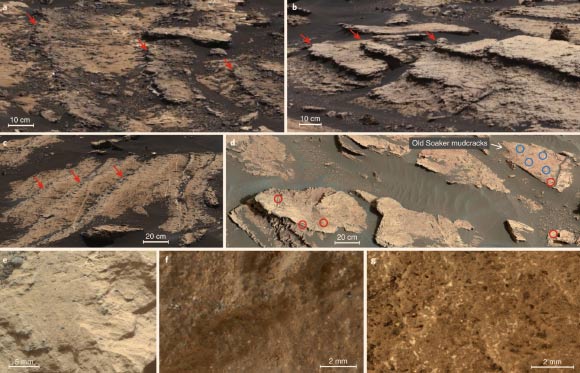NASA’s Curiosity rover recently discovered rocks enriched in mineral salts within the 3.7-billion-year-old Gale Crater on Mars. According to a new paper in the journal Nature Geoscience, these salt-rich rocks represent evidence of shallow briny ponds that went through episodes of overflow and drying.

Lithology of sulfate enrichments in Gale Crater, Mars: (a) magnesium sulfate-enriched lithology within multiple parallel horizons (red arrows) on a large block of bedrock; (b) calcium sulfate enrichments as erosion-resistant horizons (red arrows) in mudstone; (c) multiple horizons (red arrows) where euhedral white crystals and heterogeneous calcium sulfate and magnesium sulfate enrichments were observed; (d) exposed blocks at Old Soaker with desiccation cracks; circles represent the locations of Curiosity’s ChemCam targets with calcium sulfate enrichments (red) and without (blue); (e, f) close-up images of a mudstone and a sandstone enriched in calcium sulfate; (g) close-up image of bedrock with white euhedral crystals along with empty casts/moulds. Image credit: Rapin et al, doi: 10.1038/s41561-019-0458-8.
Gale Crater is the ancient remnant of a massive impact. Sediment carried by water and wind eventually filled in the crater floor, layer by layer. After the sediment hardened, wind carved the layered rock into the towering Mount Sharp, which the Curiosity rover is climbing today.
Now exposed on the mountain’s slopes, each layer reveals a different era of Martian history and holds clues about the prevailing environment at the time.
“We went to Gale Crater because it preserves this unique record of a changing Mars,” said Caltech researcher William Rapin, lead author of the study.
“Understanding when and how the planet’s climate started evolving is a piece of another puzzle: when and how long was Mars capable of supporting microbial life at the surface?”
Dr. Rapin and colleagues describe salts found across a 500-foot (150 m) tall section of sedimentary rocks called Sutton Island, which Curiosity visited in 2017.
Based on a series of mud cracks at a location named Old Soaker, the scientists already knew the area had intermittent drier periods. But the Sutton Island salts suggest the water also concentrated into brine.
Typically, when a lake dries up entirely, it leaves piles of pure salt crystals behind.
But the Sutton Island salts are different. For one thing, they’re mineral salts, not table salt. They’re also mixed with sediment, suggesting they crystallized in a wet environment — possibly just beneath evaporating shallow ponds filled with briny water.
“Given that Earth and Mars were similar in their early days, Sutton Island might have resembled saline lakes on South America’s Altiplano,” Dr. Rapin said.
“Streams and rivers flowing from mountain ranges into this arid, high-altitude plateau lead to closed basins similar to Mars’ ancient Gale Crater.”
Lakes on the Altiplano are heavily influenced by climate in the same way as Gale.
“During drier periods, the Altiplano lakes become shallower, and some can dry out completely,” Dr. Rapin said.
“The fact that they’re vegetation-free even makes them look a little like Mars.”
_____
W. Rapin et al. An interval of high salinity in ancient Gale crater lake on Mars. Nature Geoscience, published online October 7, 2019; doi: 10.1038/s41561-019-0458-8
This article is based on text provided by the National Aeronautics and Space Administration.







